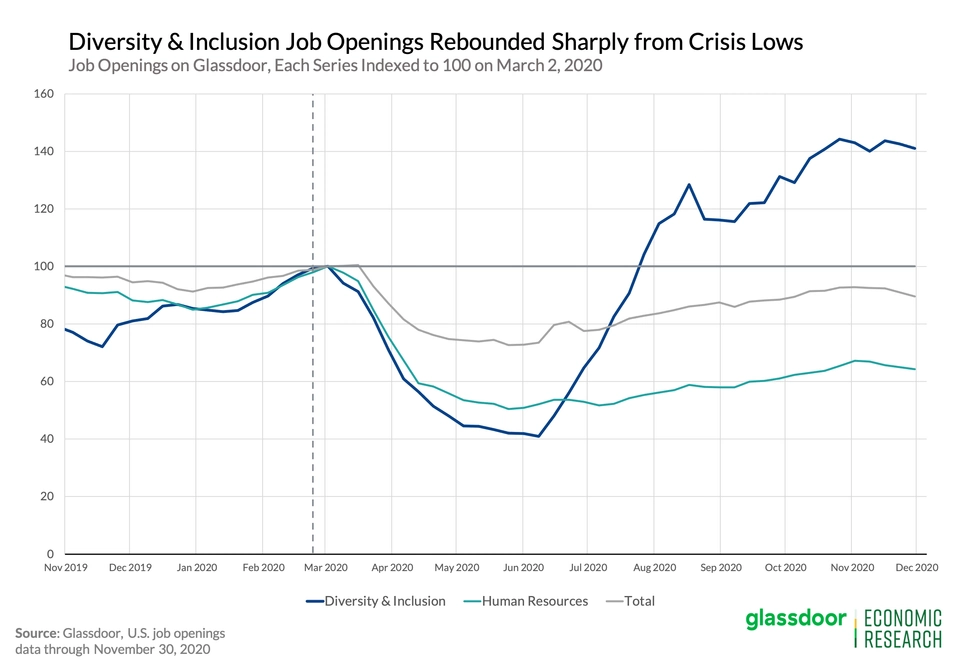- Introduction
- 2020, the COVID-19 pandemic and the rise of the DE&I role
- The 2022/23 layoffs and the fall of the DE&I role
- The impact of the layoffs on underrepresented groups
- How companies can do better
What the recent tech lay-offs mean for DE&I
Introduction
With the likes of Google, Twitter and Meta among the many tech giants letting go of huge proportions of their staff in the last few months, the recent tech layoffs have been hard to miss in the media. In fact, in 2022 alone 152,542 employees from 993 global tech companies were laid off [1]. Although these cuts may have been necessary to boost shrinking profit margins, there has been great concern that the roles cut are disproportionately affecting underrepresented groups [2]. These concerns are two-fold: The large number of DE&I roles hired in the pandemic appears to be the target of many of these cuts, and in general, research has shown that underrepresented groups have been the most affected in previous mass layoffs.
Before we look at the 2022/23 layoffs in detail, look back to the 2020 rise of the DE&I role.
2020, the COVID-19 pandemic and the rise of the DE&I role
At the start of 2020, DE&I roles were steadily on the rise (as shown in figure 1). However, as the pandemic hit, HR and DE&I roles plunged at twice the rate of overall job openings [3] until something happened in the spring that changed the trajectory of DE&I in organizations indefinitely. When African-American man George Floyd was brutally attacked by the police in May 2020, people across the globe turned to social media to express their outrage and to share their own personal experiences of racism in and out of the workplace. Organizations responded with DE&I pledges (with DE&I initiatives jumping from 29% in 2019 to 43% in 2021) [4] and many global organizations brought in their first-ever Chief Diversity and Inclusion Officer, with DE&I job postings up 123% in the three months after George Floyd’s death [5]. However now, after the hiring spree of the pandemic, and with inflation rates at a 40-year high, tech companies are laying off huge numbers of staff in a bid to save costs.

The 2022/23 layoffs and the fall of the DE&I role
The back end of 2022 saw a huge number of tech companies announce cuts to large percentages of their teams. Starting this off, in his first week at Twitter, Elon Musk halved his workforce [6], and further layoffs in February have seen the Twitter team shrink from 7500 employees just before his takeover to only 2000 now [7]. Other organizations who followed suit include Meta, cutting 11,000 jobs [8], Amazon, cutting 18,000 roles [9], Yahoo letting go of 20% of their workforce [10] and Google, cutting 12,000 employees (including those who were recently promoted!) [11]. The list of organizations letting staff off appears endless, and of this, HR and DE&I roles seem to have been disproportionately targeted. In fact, a recent report showed that while companies have been laying off 7-15% of their workforce, HR talent acquisition specialists and DE&I leaders made up 33-66% of these [12], with Twitter at the upper end of this, shrinking their DE&I team down from 30 members to just 2 [13]. In addition, listings for DE&I roles were down 19% in 2022 from the previous year [14].
The impact of the layoffs on underrepresented groups
Just as many organizations started making progress in terms of their DE&I, the recent layoffs appear to have brought this to a grinding halt, with underrepresented groups seeming to be disproportionately affected. It has been estimated that despite women accounting for less than 1/3 of the roles in the tech industry [15], 47% of those who lost their jobs in the recent layoffs were female [16] and Twitter’s mass layoffs included 57% of its female workers compared to only 47% of its male workforce [17]. Although there appears to be no published data on how the 2022/23 layoffs have impacted ethnic minorities, layoffs in the pandemic showed that these employees suffered the brunt of these job cuts, with employment rates dropping 26x more than the drop of white employees over the same period [18].
Why is this? There are various suggestions as to why underrepresented groups appear to be so affected by tech layoffs. The most popular suggestion being that females and ethnic minorities make up a large percentage of the DE&I/HR roles and so by shrinking these teams, these Individuals are more likely to be affected [19]. In addition, given that the average length of service for the recent laid-off employees was only one year, it appears that many organizations followed a “last in, first out” strategy when deciding which jobs to cut [20]. Considering the surge in hiring for HR/DE&I roles throughout the pandemic, this idea would explain why underrepresented groups appear to be the most negatively impacted now. Even so, we must ask why is it these roles are no longer a priority for organizations after only such a short period of time.
Furthermore, the cuts to HR/DE&I roles cannot exclusively explain why the percentage of underrepresented employees laid off is so high when females have been laid off at significantly higher rates even in technical positions. For instance, in the Twitter layoffs, 63% of the female engineers lost their jobs, compared to only 48% of the males [21]. The negative impact of these layoffs on DE&I is unlikely to stop with the layoffs themselves. Not only do the cuts to DE&I roles send a message to the remaining underrepresented employees that their organization does not care about them, but without the push from HR and DE&I departments, organizations are unlikely to put enough focus on hiring and retaining employees from underrepresented groups. DE&I leaders are experts in understanding the needs and experiences of minority groups and so without this, these individuals’ needs are unlikely to be met. In fact, McKinsey (2022) found that female leaders were 1.5x more likely to leave their role than males because they wanted to work for a company offering more flexibility and with a greater emphasis on employee wellbeing and DE&I [22].

How companies can do better
For companies who have not yet announced cuts, it is advised that before any decisions are made, they consider upskilling and redeploying their current talent. When laying off employees is the only option, organizations must factor DE&I into any final decisions. These decisions should be bias-free and representative of the demographic of the organization and it is vital that organizations maintain their core DE&I champions.
For those who have already made their cuts, here are some initiatives that can help boost DE&I efforts
-
Evaluate the impact of the layoffs on DE&I: conduct an analysis of the impact to highlight any disparities based on factors such as gender, race or ethnicity and develop a plan to narrow this in the coming years.
-
Provide support to affected employees: companies should provide support to the employees who were laid off, including resources for job searches and career development.
-
Provide support to remaining employees: even remaining employees are likely to feel wounded by the layoffs. If leaders they aspired to were let go, they may feel pessimistic about their future in the organisation. Provide resources such as mental health services as well as professional development opportunities and open up the conversation to see how you can help boost morale.
-
Continue DE&I approaches: Keep on planning and executing your current DE&I strategy where possible.
Finally, if you were affected by the recent tech layoffs, many sectors are still scaling such as Oil and Gas and Gaming and so do consider checking out those spaces.
Author: Emma Bluck (Marketing and Scientific Communications Lead)
Start Building a Fairer Workplace With Us
Dive into the future of work with our expertly crafted solutions. Experience firsthand how MeVitae’s AI-driven solutions can make a difference. Request a demo or consultation now.
